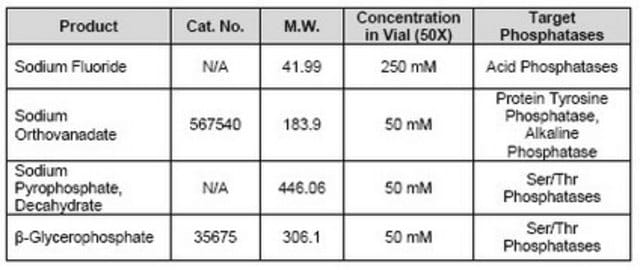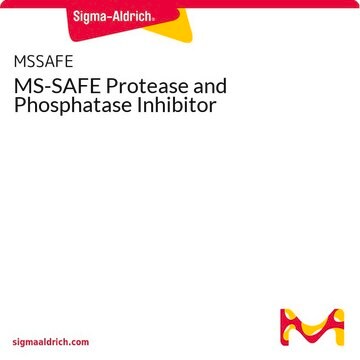524628
Phosphatase Inhibitor Cocktail IV
liquid, for the inhibition of serine/threonine and alkaline phosphatases
Synonyme(s) :
Phosphatase Inhibitor
About This Item
Produits recommandés
product name
Phosphatase Inhibitor Cocktail Set IV, Phosphatase inhibitor Cocktail Set IV is a cocktail of three phosphatase inhibitors for the inhibition of both serine/threonine and alkaline phosphatases.
Forme
liquid
Fabricant/nom de marque
Calbiochem®
Conditions de stockage
OK to freeze
protect from light
Conditions d'expédition
wet ice
Température de stockage
−20°C
Catégories apparentées
Description générale
Actions biochimiques/physiologiques
Serine/threonine and alkaline phosphatases
Avertissement
Forme physique
Reconstitution
Informations légales
Code de la classe de stockage
10 - Combustible liquids
Classe de danger pour l'eau (WGK)
WGK 1
Point d'éclair (°F)
188.6 °F - (refers to pure substance)
Point d'éclair (°C)
87 °C - (refers to pure substance)
Certificats d'analyse (COA)
Recherchez un Certificats d'analyse (COA) en saisissant le numéro de lot du produit. Les numéros de lot figurent sur l'étiquette du produit après les mots "Lot" ou "Batch".
Déjà en possession de ce produit ?
Retrouvez la documentation relative aux produits que vous avez récemment achetés dans la Bibliothèque de documents.
Les clients ont également consulté
Notre équipe de scientifiques dispose d'une expérience dans tous les secteurs de la recherche, notamment en sciences de la vie, science des matériaux, synthèse chimique, chromatographie, analyse et dans de nombreux autres domaines..
Contacter notre Service technique













